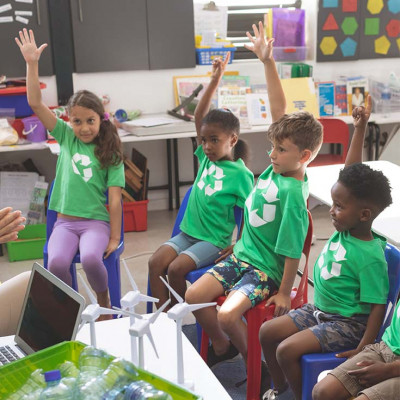 Green Team Tips
Green Team Tips

The primary motivation for schools to participate in the Green Team initiative is to broaden students’ horizons beyond traditional curriculum and teach them about their individual responsibility to respect, preserve and protect the increasingly fragile environment that surrounds them.
Recycling helps control rising waste disposal costs, conserves resources and energy, and facilitates compliance with local and state recycling mandates.
Schools, as trusted learning institutions, can play a significant part in helping students better understand the concept of teamwork as it relates to conservation practices, how to take responsibility and initiative, how to set and attain goals, and the power of individuals acting collectively to make an impact and effect change. These are valuable life lessons that will serve both the students and the environment—now and in the future.
The first step in setting up your school’s recycling program is organizing your green team.
Leader
The green team should include a leader/coordinator who is responsible for planning, directing, implementing and monitoring your program, as well as team members consisting of other faculty, teacher’s aides, PTO members, students, custodial and cafeteria staff.
Custodians
Custodians are key players in the school recycling effort. Their input is critical and should be included early on in the planning process, since they are instrumental in overseeing how waste and recyclables move through the building and into the proper receptacles.
Teachers
Teachers should be enlisted to support the program in the classroom, teacher’s lounge and cafeteria. They are needed to urge student participation and to encourage school projects and field trips that involve recycling.
The responsibilities of team members, at least initially, is to gather and organize information that will be used in planning, publicizing, executing and monitoring the program, and then once the program is well-established, to serve as the team leader’s trusted advisors. Additional responsibilities should be identified and assigned based on your school’s needs.
Once the team has been assembled, you can begin the critical tasks that will make your school recycling program successful.
- Conduct a waste audit- Identify the origin of waste, the type of material (paper, plastics, metal and glass) and the volume. The team should look at classrooms, the cafeteria, library, faculty lounge and administrative offices. Then, determine what items can be recycled, reused, reduced and eliminated.
- Identify what to recycle- Identify those items your school can and should recycle. It will likely be white and colored paper, corrugated cardboard, milk cartons and juice boxes, plastic bottles, and aluminum & steel cans. It's best to start out with a limited number of materials and then add others as the collection system and the program becomes more refined.
- Establish your collection system- We recommend placing containers directly at the place of origin. Containers should be placed in classrooms, offices, faculty lounges, kitchens, cafeterias, and near vending machines. It is important that containers are highly visible, properly labeled and include appropriate signage not only to direct users to them, but also to avoid contamination and mixing of recyclable and non-recyclable waste.
- After collection- The recycled items should be stored in a separate, designated area for holding all materials prior to pick-up by your school's waste and recycling hauler.

